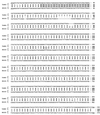A beta-1,3-N-acetylglucosaminyltransferase with poly-N-acetyllactosamine synthase activity is structurally related to beta-1,3-galactosyltransferases
- PMID: 9892646
- PMCID: PMC15149
- DOI: 10.1073/pnas.96.2.406
A beta-1,3-N-acetylglucosaminyltransferase with poly-N-acetyllactosamine synthase activity is structurally related to beta-1,3-galactosyltransferases
Abstract
Human and mouse cDNAs encoding a new beta-1, 3-N-acetylglucosaminyltransferase (beta3GnT) have been isolated from fetal and newborn brain libraries. The human and mouse cDNAs included ORFs coding for predicted type II transmembrane polypeptides of 329 and 325 aa, respectively. The human and mouse beta3GnT homologues shared 90% similarity. The beta3GnT gene was widely expressed in human and mouse tissues, although differences in the transcript levels were visible, thus indicating possible tissue-specific regulation mechanisms. The beta3GnT enzyme showed a marked preference for Gal(beta1-4)Glc(NAc)-based acceptors, whereas no activity was detected on type 1 Gal(beta1-3)GlcNAc and O-glycan core 1 Gal(beta1-3)GalNAc acceptors. The new beta3GnT enzyme was capable of both initiating and elongating poly-N-acetyllactosamine chains, which demonstrated its identity with the poly-N-acetyllactosamine synthase enzyme (E.C. 2.4.1.149), showed no similarity with the i antigen beta3GnT enzyme described recently, and, strikingly, included several amino acid motifs in its protein that have been recently identified in beta-1,3-galactosyltransferase enzymes. The comparison between the new UDP-GlcNAc:betaGal beta3GnT and the three UDP-Gal:betaGlcNAc beta-1,3-galactosyltransferases-I, -II, and -III reveals glycosyltransferases that share conserved sequence motifs though exhibiting inverted donor and acceptor specificities. This suggests that the conserved amino acid motifs likely represent residues required for the catalysis of the glycosidic (beta1-3) linkage.
Figures





Similar articles
-
Molecular cloning and expression analysis of a mouse UDP-GlcNAc:Gal(beta1-4)Glc(NAc)-R beta1,3-N-acetylglucosaminyltransferase homologous to Drosophila melanogaster Brainiac and the beta1,3-galactosyltransferase family.Glycoconj J. 2000 Dec;17(12):867-75. doi: 10.1023/a:1010921313314. Glycoconj J. 2000. PMID: 11511811
-
Cloning and expression of a novel UDP-GlcNAc:alpha-D-mannoside beta1,2-N-acetylglucosaminyltransferase homologous to UDP-GlcNAc:alpha-3-D-mannoside beta1,2-N-acetylglucosaminyltransferase I.Biochem J. 2002 Jan 1;361(Pt 1):153-62. doi: 10.1042/0264-6021:3610153. Biochem J. 2002. PMID: 11742540 Free PMC article.
-
Cloning of a mouse beta 1,3 N-acetylglucosaminyltransferase GlcNAc(beta 1,3)Gal(beta 1,4)Glc-ceramide synthase gene encoding the key regulator of lacto-series glycolipid biosynthesis.J Biol Chem. 2001 Aug 10;276(32):30261-9. doi: 10.1074/jbc.M102979200. Epub 2001 May 30. J Biol Chem. 2001. PMID: 11384981
-
Sequence-function relationships of prokaryotic and eukaryotic galactosyltransferases.J Biochem. 1998 Jun;123(6):1000-9. doi: 10.1093/oxfordjournals.jbchem.a022035. J Biochem. 1998. PMID: 9603985 Review.
-
Why are glycoproteins modified by poly-N-acetyllactosamine glyco-conjugates?Curr Protein Pept Sci. 2003 Feb;4(1):1-9. doi: 10.2174/1389203033380304. Curr Protein Pept Sci. 2003. PMID: 12570780 Review.
Cited by
-
N-glycosylation in regulation of the nervous system.Adv Neurobiol. 2014;9:367-94. doi: 10.1007/978-1-4939-1154-7_17. Adv Neurobiol. 2014. PMID: 25151388 Free PMC article.
-
β3GnT2 maintains adenylyl cyclase-3 signaling and axon guidance molecule expression in the olfactory epithelium.J Neurosci. 2011 Apr 27;31(17):6576-86. doi: 10.1523/JNEUROSCI.0224-11.2011. J Neurosci. 2011. PMID: 21525298 Free PMC article.
-
Axon guidance events in the wiring of the mammalian olfactory system.Mol Neurobiol. 2009 Feb;39(1):1-9. doi: 10.1007/s12035-008-8047-7. Epub 2008 Dec 2. Mol Neurobiol. 2009. PMID: 19048417 Review.
-
GfsA encodes a novel galactofuranosyltransferase involved in biosynthesis of galactofuranose antigen of O-glycan in Aspergillus nidulans and Aspergillus fumigatus.Mol Microbiol. 2013 Dec;90(5):1054-1073. doi: 10.1111/mmi.12416. Epub 2013 Oct 21. Mol Microbiol. 2013. PMID: 24118544 Free PMC article.
-
Structural characterization of the N-glycans of gp273, the ligand for sperm-egg interaction in the mollusc bivalve Unio elongatulus.Glycoconj J. 2001 Jul;18(7):511-8. doi: 10.1023/a:1019617728660. Glycoconj J. 2001. PMID: 12151712
References
-
- Kleene R, Berger E G. Biochim Biophys Acta. 1993;1154:283–325. - PubMed
-
- Harduin-Lepers A, Recchi M-A, Delannoy P. Glycobiology. 1995;5:741–758. - PubMed
-
- Reguigne-Arnould I, Couillin P, Mollicone R, Faure S, Fletcher A, Kelly R J, Lowe J B, Oriol R. Cytogenet Cell Genet. 1995;71:158–162. - PubMed
-
- Hagen F K, Nehrke K. J Biol Chem. 1998;273:8268–8277. - PubMed
-
- Van den Eijnden D H, Joziasse D H. Curr Opin Struct Biol. 1993;3:711–721.
Publication types
MeSH terms
Substances
Associated data
- Actions
- Actions
LinkOut - more resources
Full Text Sources
Other Literature Sources
Molecular Biology Databases

